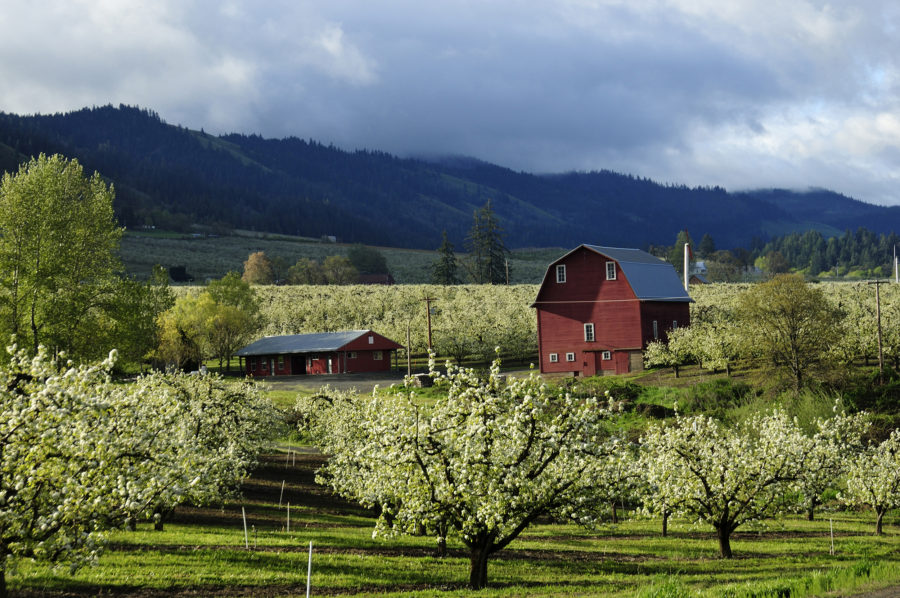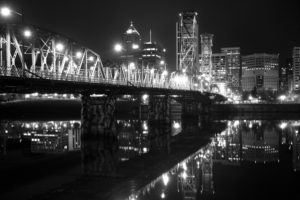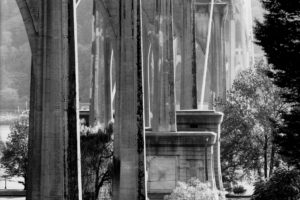Driving through the Columbia Gorge, as I do back and forth to work every weekday could have a tendency to make the spectacular into the mundane. I think about this sometimes when the light isn’t quite right, and I decline to get out a camera because because the stunning vista before me looks a little gray. I wonder at these times how someone from somewhere less dramatic would see it, and at that point I get out the camera.
My commute is fairly long: About an hour each way. I live in Hood River (a fact that I’ve mentioned a few times on this here blog). I best describe it as the place closest to the concept of paradise to be found in the northern hemisphere. I work in a place called Gresham, which is akin to where Dante’ ended up after leaving paradise (with apologies to Gresham residents). Fortunately, It’s only the First Circle. Work is about 52 miles from Hood River as the crow flies, unless it finds some delectable squirrel jerky on the way.
Always, to my mind in the last 27 years since moving to Oregon, the Columbia Gorge was the Columbia Gorge: Timeless beauty with lush greenery, waterfalls, and monumental cliffs. I wonder what it would be like to soar like an eagle off of a high ledge, and be held aloft be the wind, and to see that landscape under me (and to not be looking solely for rodents, and other fauna that goes “squeak!”). I’m certain I would want to have a camera. This “always”, and “timeless” was put though a test late last year.
It was called the Eagle Creek Fire.
The Summer Solstice was long gone, as were the short nights. Darkness was creeping back into my commute. Labor day came, and the trails were filled to the gills with hikers. One of them was packing fireworks.
Some climatological notes: Unless you live east of the Mississippi, you should understand that the Dog Days of Summer in the west leave parched bones in the desert. In the Pacific Northwest, fall, winter, and spring are wet (Portlanders joke about having webbed feet), but toward the end of June, the weather changes. The dry time begins. Lawns die, rivers run low, and trees with shallow root systems struggle to make it into fall. Everyone who lives in the Great American West should understand that during the dog-eared, tongue-hanging-out days of late summer, YOU DON’T TAKE FIREWORKS TO THE COLUMBIA GORGE!
Ahem. Now, where was I?
Oh, I remember. This is about hope springing eternal.
Spring is indeed here. During my weekday excursion up and down the Columbia river, I watch the trees. I am fascinated by the way they change throughout the year. In the spring, they bud, blossom, and burst out in brilliant greens, pinks, whites, and yellows. The wreckage that is the Cottonwood trees, which always seem to be a month or so away from death in the winter, gather their sap, and join the world of the living for another season. The spruces, and various pines stand resolute against the howling winds and driving rain, and well, they don’t change very much. This year, it’s a bit different. I have been watching the burned areas to see where the green is coming back. I keep an eye on the soils to see if plants are growing. I look at the pines to see if they are putting on new needles where the fire stripped them. I am reminded that life is tenacious. I’m seeing green where I did not expect it. The hills, especially around Cascade Locks, did not fare very well. But, could it be possible that green is sprouting up on the hills, below the burned trees? I will know it when the Forest Service allows me to hike the trails again.
The Columbia Gorge I knew until September 2017 will not return in my lifetime. But, I can watch it come back. Little by little, hope returns, life goes on, and the challenge is to reflect that in the way we live our lives. Be the life you want to bring. Be the change that you want to see. As Ram Das said, be here now.
About the photograph: I captured it with a Sinar Alpina 4×5 camera on Ilford Ortho Plus film, which I developed in PMK Pyro. I stumbled upon this combination by accident, but it’s a match made in heaven. The stairs are located just east of the Bonneville Dam, and were built by the Franklin Roosevelt’s WPA.
In retrospect, seven years after the fire, I can say thankfully that the gorge has not burned again, although it is becoming more likely as climate change worsenes. There was a large fire again above Casdace Locks in the summer of 2024, but luckily it did not experience the explosive growth that the Eagle Creek Fire did.
The Gorge is still stunningly beautiful, but the signs of the fire are everywhere. Dead trees abound, and rock and mud slides are more frequent, changing the landscape, and making it harder to keep trails open.
©2021 Gary L. Quay
Burn scars on the trees near Eagle Creek in the Columbia Gorge, Oregon. The underbrush is coming back three years after the fire. Nature is healing herself.
Camera: Nkon D810
Lens: 24-85mm Nikon
©2021 Gary L. Quay
Regrowth in the Columbia Gorge near Cascade Locks
Camera: Nikon D810
Lens: 28mm Zeiss Distagon ZF2
I will try to add some pictures from 2024 in the near future. I have not been hiking as much since I started with the Portland Saturday Market. I have a couple months off to get out more.

















